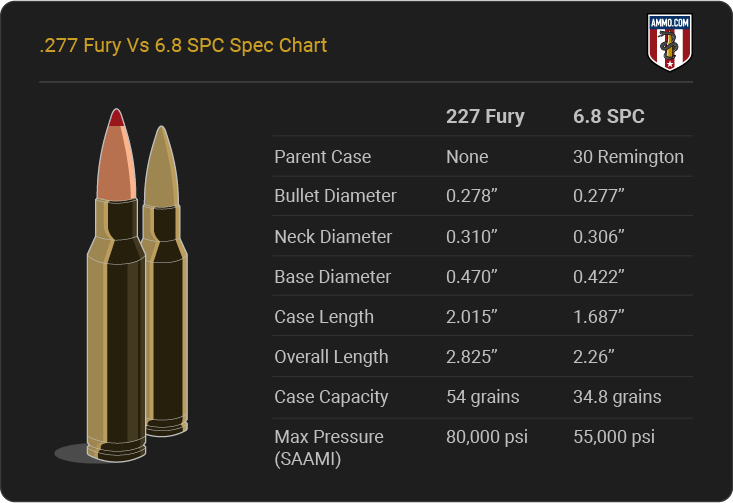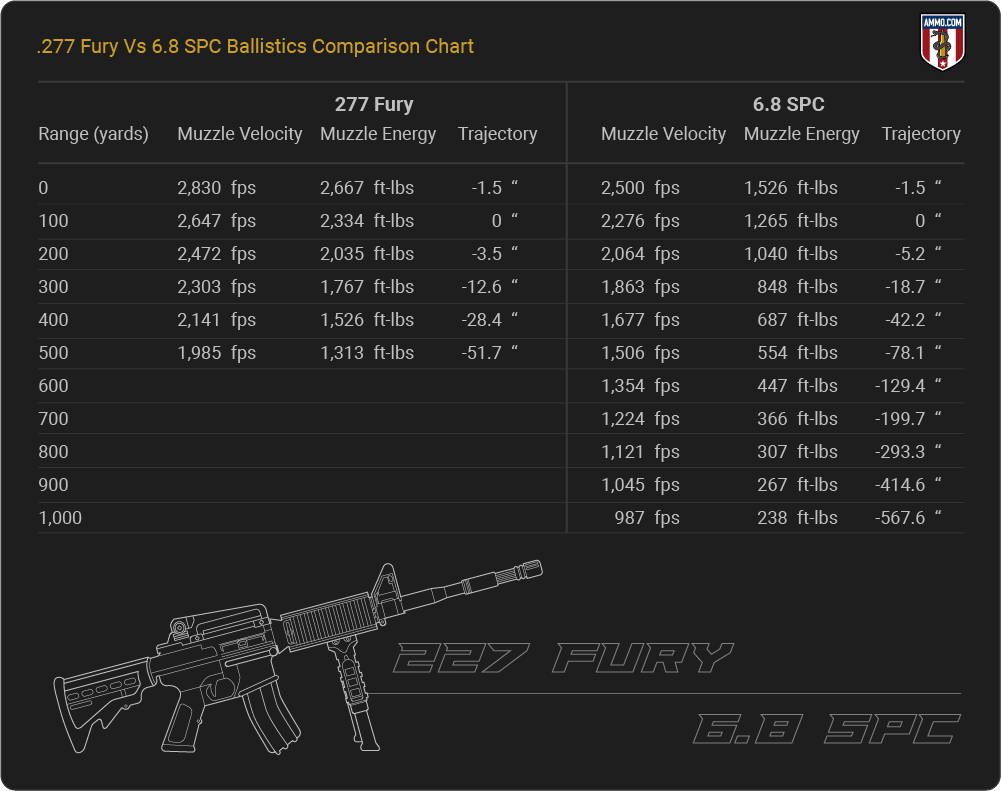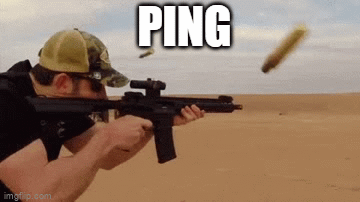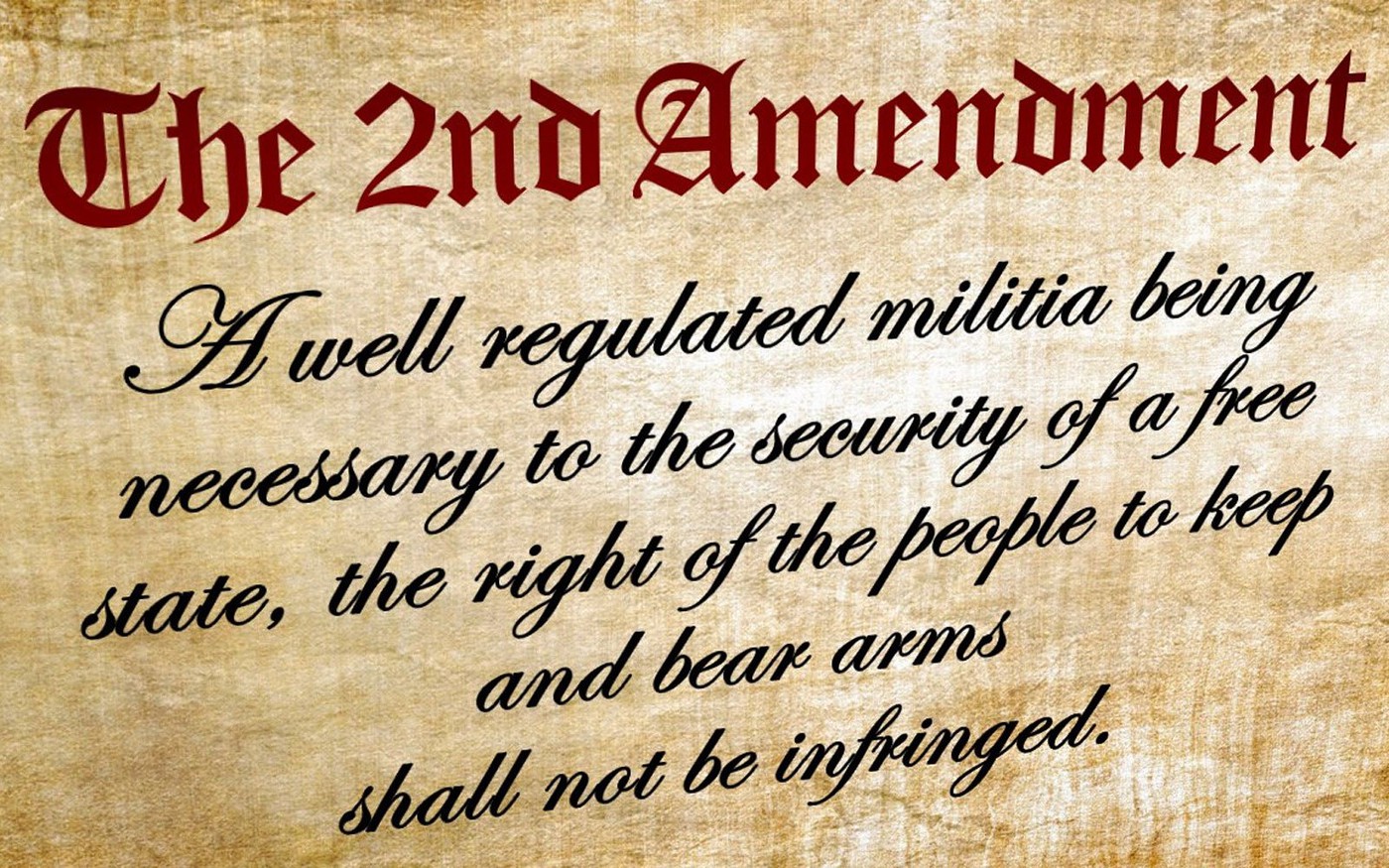
Posted on 01/29/2024 8:51:48 AM PST by Red Badger
When the U.S. Military requested a new cartridge for the battlefield, Remington and Sig Sauer responded with their own variations of .277” diameter projectiles. Remington’s 6.8 SPC didn’t make the cut, and Sig went above and beyond, designing a revolutionary new cartridge and a rifle to boot.
Just because the Army opted to go with Sig’s .277 Fury doesn’t mean it’s going to be the best option for the consumer. In fact, there are a few reasons it may not be best for our guys in the field. Nonetheless, we’re excited to see the .277 Fury hit the market.
These two calibers have many similarities, but yet they serve two very different purposes. They each have strengths and weaknesses, so getting a well-rounded comparison is best.
Otherwise, hang out with me for a bit while I tell you everything you need to know about the .277 Fury and 6.8 SPC.
.277 Fury Vs. 6.8 SPC Caliber Comparison If you’ve been keeping up with gun forums and small arms news, you’re probably aware that the U.S. Army awarded the Next Generation Squad Weapon program (NGSW) contract to Sig Sauer and the .277 Fury in 2022.
Sig Sauer developed an entirely new weapon system in the XM5 and XM250 to complement their new cartridge and replace the aging M4 Carbine and M249 SAW and the 5.56 NATO cartridge.
However, Remington also submitted the 6.8 Special Purpose Cartridge, or 6.8 SPC, decades prior in 2004. While the 6.8 SPC didn’t quite make the cut, it is an impressive option for those looking to upgrade their AR-15s.
I’m going to discuss both of these cartridges in the following sections. But before I dive into them, it’s important to note that the .277 Sig Fury and the 6.8 SPC have two variations.
Sig developed a standard and hybrid version of the .277 Fury. The standard .277 Fury cartridge has a basic brass case with a max pressure similar to that of the 6.8 SPC.
However, the hybrid case consists of three separate parts to make up the entire cartridge. First there is the stainless steel base, an aluminum locking washer, and a standard brass case body.
That’s the one that the Army is interested in, and at the time of writing, there is only one rifle available to civilians for the 277 Fury, that being the Sig Cross bolt-action rifle. Sig has promised a civilian variation of the MCX-Spear, but we have yet to see it.
Back in 2004, Remington looked like it almost had a new cartridge contract locked down with their revolutionary 6.8 SPC design. But sadly, they dropped the ball, and the military decided not to pursue the 6.8 SPC due to chamber pressure issues.
Remington ultimately fixed the chamber pressure issue, but by that time, the military was disinterested in the round. This left the civilian market with barrels stamped with 6.8 SPC and the 6.8 SPC II.
Now that I’ve cleared that up, the following sections will give you a full 360 view of the 6.8 SPC and the .277 Fury Hybrid.
Cartridge Specs

The first place to begin your quest for understanding cartridges is the cartridge specs. Variations in bullet diameter, case capacity, and pressure give us insight into what these cartridges can do on the range, in self-defense situations, in hunting, and even in battle.
As you can see in our comparison, the .277 Fury is a bit larger than the 6.8 SPC (6.8x42mm compared to 6.8x51mm). But the most notable difference between the two cartridges is the massive difference in SAAMI chamber pressures at 80k psi versus 55k psi.
At the time of writing, the 277 Fury has the highest approved chamber pressure of all time, even outstripping the 338 Lapua Magnum and 50 BMG.
The increase in pressure means the .277 Sig Fury will have a higher muzzle velocity and more energy than the 6.8 SPC could ever dream of. Sig easily defeated Remington in case specs, even in rifles with shorter barrel lengths.
Realistically, the .277 Fury is a beast compared to the 6.8 SPC. But the 6.8 SPC was designed for America’s last generation of weaponry (the M4), while the .277 Fury is more tailored for the future and for punching through modern body armor. So, it isn’t surprising that the Fury pushes the limits further.
Recoil Recoil is another important aspect to consider before choosing a brand-new caliber. A rifle with too much recoil is unpleasant to shoot and indirectly affects accuracy and efficiency (realigning your sights with the target, flinching before shooting, etc.).
The muzzle velocity (FPS), powder charge, rifle weight, and bullet weight all affect recoil. The military version of the .277 Fury has much more recoil than the 6.8 SPC, thanks to all of these factors.
In fact, the 6.8 SPC only has around 9 ft-lbs of recoil and the .277 Fury has about 18-20 ft-lbs depending on your factory load of choice and rifle weight. That means the 6.8 SPC has less than half the felt recoil of the 277 Fury, which is pretty significant.
While I wouldn’t necessarily recommend either of these options to novice shooters (the 5.56 is a popular choice for beginners for a reason), if you’re planning your next upgrade, the 6.8 SPC wins for its lower recoil.
Trajectory
I’ll come right out and say it: the .277 Sig Fury easily wins over the 6.8 SPC in terms of trajectory.
Trajectory refers to how flat a projectile travels from barrel to target. The flatter the trajectory, the less shooters have to adjust their sites for long-range hits. A flatter trajectory can also compensate for shooter ranging errors to some extent.
Trajectory is a really important aspect in long-range shooting because we need our bullets to stay on a solid path for a longer period. Fortunately, the .277 Sig Fury has an excellent trajectory, even with short barrels. It can maintain high velocities at ranges further than most comparable calibers, even the 6.5 Creedmoor.
Now, if you’re only interested in close-range shots or CQB, this is a non-issue. The less time the projectile spends in the air, the less it drops and drifts.
For medium range or designated marksman rifle (DMR) work between 200 to 300-yards, both rifle cartridges perform perfectly fine.
However, for long-range work, the 277 Fury is clearly the better choice.
Ballistic Coefficient Both the 6.8 SPC and .277 Sig Fury have a pretty high ballistic coefficient. For those new to the subject, the ballistic coefficient defines how well a bullet can resist the wind in flight. Essentially, it tells us how aerodynamic the bullet is.
There are many factors that contribute to how well a bullet can overcome wind drift, but things like bullet weight and design can increase or decrease the B.C. But the important thing to note is the higher the number, the better job the projectile does of resisting wind and gravity.
Now, the ammo you choose will have some effect on the B.C. For example, the 6.8 SPC shoots lighter bullets, which tend to be more affected by atmospheric variables, while the .277 Fury shoots heavier ones.
For example, the Elite Polymer Tipped .277 Fury Hybrid 150-grain bullet has a ballistic coefficient of 0.500. We can compare this to the popular 6.8 SPC Hornady Black 110-grain V-Max with a ballistic coefficient of only 0.370.
The .277 Fury, by design, will typically have a higher B.C. than the 6.8 SPC.
Muzzle Velocity and Kinetic Energy
The .277 Fury easily beats the 6.8 SPC in muzzle velocity and kinetic energy thanks to its higher case capacity. In fact, the Sig Fury Hybrid beats most other popular options in its category, thanks in part to its 80k psi chamber pressure.
.277 Sig Fury 135-grain FMJs have 2,697 ft-lbs of muzzle energy and 3,000 fps of muzzle velocity. Meanwhile, Hornady Black 6.8 SPC 110-grain only has 1,588 ft-lbs and 2,570 fps of muzzle velocity.
Not only is velocity and energy important at the barrel, the Army needed something that would maintain its speed and penetrate modern body armor at long-range distances. The .277 Fury Hybrid maintains velocities over 2,000 fps at 500 yards with only a 51-inch drop. On the other hand, the effective range of the 6.8 SPC is only about 500 yards, with a 78” drop at 500 yards.
Clearly, the 6.8 SPC is perfect for those of us who want to go plinking or hunting. But for our guys on the battlefield, the .277 Fury simply outperforms.
Ammo and Rifle Cost/Availability The winner of this category is the 6.8 SPC. Unfortunately, .277 Sig Fury ammunition is exceptionally challenging to find as Sig Sauer is the only company currently producing it. And although the 6.8 SPC isn’t overflowing on your local gun store shelves, it’s still a lot easier to find than 277 Fury ammo.
Now, that may be in part due to the fact that it’s a much newer cartridge. However, we expect .277 Fury cartridges to be made in the Lake City ammo plant, which currently isn’t selling ammo to civilians.
Finally, many firearm manufacturers make all sorts of rifles, from bolt-actions to AR-15s chambered in 6.8 SPC. If you’re looking for availability, 6.8 SPC is it.
Hunting
My readers who are feeling a little down about the 6.8 SPC can rejoice in the hunting section. Sure, on paper, the .277 Fury can outperform the 6.8 SPC at the hunting club. However, there are several advantages to hunting with the 6.8 SPC.
First, ammunition. Sig is the only company producing ammunition for the .277 Fury, and this includes hunting ammo. The 6.8 SPC, on the other hand, comes from many manufacturers like Hornady, Winchester, etc.
Next, you don’t need a proprietary rifle to hunt with your 6.8 SPC. You can easily convert your AR-15 to fire 6.8 SPC with a simple barrel, bolt, and magazine change. However, at the time of writing there are no factory bolt-action rifles chambered in 6.8 SPC.
Finally, the caveat with the 6.8 SPC is that it isn’t a great elk or big game hunting cartridge. So, it’s best to stick with deer and smaller critters. Furthermore, your effective range with the 6.8 SPC is going to be a maximum of 250-300 yards (unless you’re using Hornady subsonic ammunition that’s designed to expand at lower velocities.
Overall, the 6.8 SPC is the better hunting option because it’s more available and has a great range. But if you want to take a trophy elk at 800 yards, then the .277 Sig Fury is the better choice.
Self-Defense/Home Defense Both of these cartridges were designed with CQB in mind. They both have high muzzle energy and will certainly stop any threat in your home.
However, if I were choosing one for home defense, it’d be the 6.8 SPC. Despite all of the advantages of the .277 Fury, a few fundamental aspects of the 6.8 SPC give us an advantage here.
The first advantage is how much ammo you can stockpile. Unfortunately, .277 Fury ammo isn’t as widely available as 6.8 SPC. So, naturally, I’m going with the one I can get ammunition for.
Next, Sig promised civilians a 277 Fury version of the Sig MCX-Spear that can handle the hybrid loads in 2023 (it won’t be a machine gun, unfortunately). Sadly, that hasn’t happened yet and Sig has failed to provide us with a delivery date on that promise.
But even if a Spear was available in 277 Fury, the main issue you’ll have with this cartridge is over penetration. With so much power behind it, the 277 will easily blow through your interior walls and could potentially strike your loved ones or your neighbors next door.
However, since the 6.8 SPC is designed to increase the stopping power of the 5.56 and any standard AR-15 carbine can easily be converted to fire the SPC, it’s clearly the better choice for home defense thanks to a lower chance of penetration and considerably higher ammo availability.
Finally, I’d like to mention that neither of these options is as readily available as similar long-range civilian cartridges like the 6.5 Grendel or 6.5 Creedmoor. So, if you’re new to rifles and looking for something with great range and ballistics, it might be best to read up on other calibers entirely.
Reloading Reloading is becoming a great American pastime, and it’s important to consider what you can and can’t reload before upgrading to a new cartridge.
If your main focus right now is obtaining something you know is reloadable, it’s best to stick with the 6.8 SPC. This cartridge has been around for quite a while, so everything from the dies to the bullets is pretty easy to find. Furthermore, the reloading data is readily available as well.
However, Sig has indicated that even the hybrid case will be reloadable. Unfortunately, we don’t know how long it will be before the company releases any load data. So, unless you want to wait it out, the 6.8 SPC is better for reloading.
Ballistics
Remington and Sig aimed to increase the lethality of the military’s beloved 5.56 NATO rounds. Fortunately, both did create cartridges with some improvements. The following charts will show you how well they perform.

6.8 SPC Development and History
Back in 2004, Remington Arms teamed up with the US Special Operations Command and the U.S. Army Marksmanship Unit to design a new cartridge for the M4 carbine. The trio wanted to create a cartridge with better terminal ballistics in CQB. Essentially, they wanted to do this while keeping the M4 and modifying existing components to work better.
Master Sgt. Steve Holland and Chris Murray took the lead on the project, and they modified a 30 Remington case to fit in the chamber of the M4. This allowed for heavier projectiles and more pressure, so it seemed like a great idea at the time. Especially because it had excellent energy transfer in shorter barrels.
Unfortunately, Remington botched the chamber designs on the original 6.8 SPC leading to a potential for rounds to be over chamber pressure specs. Remington took it back to the workbench and underloaded the ammo instead of fixing the chamber. So, the military had a brand new rifle cartridge that was underpowered. Not unsurprisingly, they passed.
Remington, however, didn’t give up on the civilian market. They tweaked minor things like adding 0.50” of free bore to the chamber and reducing the twist rate. Finally, the 6.8 SPC performed well but it was too late for the military side of the cartridge.
.277 Fury Hybrid Development and History
When the U.S. military asked the private sector to come up with a .277 caliber cartridge, Sig answered the call. Unlike Remington, however, Sig didn’t reuse outdated casings and match the cartridge to the M4.
Sig went above and beyond, creating a new rifle and revolutionary case for its 6.8x51mm cartridge. Sig’s new weapons system consists of the XM5 and it’s belt-fed LMG counterpart, the XM250. Coupled with .277 Fury ammunition, these rifles were unveiled in 2019 as the winners of the NGSW (Next Generation Squad Weapon) program for the United States military.
Although we don’t have a lot of details just yet regarding exactly how this short-action rifle with magnum power came to be, we do know that the military was asking for a very specific weapon, and Sig was able to deliver it.
The military needed something that can pierce level 4 modern body armor at longer ranges than the 5.56 NATO, and word has it that the .277 Fury can do it. Furthermore, it has a lot of energy for CQB (close-quarter battle) to ensure effective hits and knock-down threats.
Some critics of the cartridge have raised concerns about the carry weight of this ammunition because it is heavier. Furthermore, the case design has never been tried and tested in the desert or frozen tundra, so we can’t be certain we won’t see malfunctions in the coming years.
Nonetheless, it seems like a solid solution so far, and we’re excited to see how it performs.
Parting Shots
It’s been quite a few decades since a new weapon system came on the scene. The US Military has been using 5.56 NATO since Vietnam, so the fact that the Army is testing new weaponry isn’t too surprising.
It’s likely that we haven’t seen the last of 5.56 NATO on battlefields. In fact, adding a new, more versatile, and high-pressure rifle cartridge with better armor-piercing capabilities to the lineup seems to be the end goal.
Fortunately, whether you’re in the military, interested in military arms, or you’re a civilian looking for some new cartridges, the .277 Fury and 6.8 SPC have something for everyone.
.277 Fury vs 6.8 SPC: The Best of the Best of the Best? Sure originally appeared in The Resistance Library at Ammo.com.
Oh, wait, I see what you’re saying. It’s a typo...............
The other elephant in the room is that they'll be moving from a 6-pound rifle to a 9-pound rifle, more, of course, with the high-tech optics the military has become so fond of (and for reason). That's difficult to avoid if you're after terminal energy with reasonable recoil. But that's three (or whatever it actually turns out to be) more pounds of rifle that translates to three less pounds of other gear.
As a side note, I wish commentators would lose the silly affectation of worrying about a battle rifle penetrating too much drywall to keep the babies in the next room safe. This thing was designed to penetrate level 4 body armor at range, f'Petessake. Give it up.
We can’t all run around with 50 caliber in our cars and trucks................yet....................
For later.
L


This Ping List is for all news pertaining to infringes upon or victories for the 2nd Amendment.
FReepmail me if you want to be added to or deleted from this Ping List.
More 2nd Amendment related articles on FR's Bang List.
The prices are too high, but will go higher, mostly due to democrats.
BLOAT = Buy Lots of Ammo Today!
Finally they come up with something which has a distinct advantage over the old 556/M4.
Many of the suggestions in the past would have cost a lot to implement but not afforded and true advantage.
This new cartridge and rifle combo does provide an advantage.
Specifically, body armor. Everyone has it today. Heck, 21 years ago in Iraq ~ 1/4 of all the Iraqi troops had it. Today if you look at Ukraine, practically every Ukrainian and Russian have advanced hard plate armor...
The old 556 was great in a world where people had no or at most soft body armor. It’s time is already past!
Next, we need to replace our 9mm. While it might be a bridge to far to expect a short barrel, small cartridge to punch through ceramics and uhmwpe, at least we should address the soft armor which can be defeated with smaller, higher velocity, better shaped, and hard/laminated type penetrating bullets, say something like FNs: https://en.wikipedia.org/wiki/FN_Five-seven
The proliferation of more advanced body armor has changed everything.

The 6.8 SPC was fun to shoot when Federal XM68GD was plentiful and reasonably priced. The Fury is clearly superior, but it’s also not an “AR-15” cartridge like the SPC, so not really comparable. It requires a larger chamber weapon like the AR-10, where it has other competition like the 6.5 Creedmoor.
review
Not really, Sight in at 50 or 100 yards wont change noticeably at all, drop at 300 yards and beyond is different but predictable
... the recoil is vastly different,...
Why? its still a buffered system. Do you feel any significant difference between a lower velocity .223 at say 2400 ft/s and an M193 5.56 round at 3200 ft/s? I can tell but it doesnt affect how I shoot.
and the training received with the lower recoil .277 all brass ammo will be less useful and meaningful when it comes time to use the full power .277 composite cased ammo in battle.
I disagree, but thats my opinion.
As a result, the .277 Fury will end up being a specialist weapon ...
This may be true. If not, its just going to cost us taxpayers a whole lot more for the expensive ammo. With the proliferation of body armor, is it worth it? It may be if thats what it takes to be more effective on the battlefield.

We wouldn’t have to worry about that if we’d just go back to the practice of gun bearers. I would insist.
Why is this better than .308/7.62 nato?
Longer range and the weapon looks really scary to liberals...................
These new cars all have sunroofs for some reason..............
7.62 nato was the issued round in the m14 when i served in the navy 1970’s. Stout recoil., never fired one at a human target. I can tell you, it drops a whitetail on the spot. I have a hard time giving up on that 30 caliber round.
Question: What is the need to change a basic battlefield weapon and ammunition? Have combat veterans been consulted?
Or is this another proposal from the military support industry to make millions of dollars profit re-tooling a large Army, Navy, Marine force?
I read the article. Recoil is in the 20 ft lb range. Same as 150 gr. 308.
And yeah, my go to whitetail round is .308. It did the job then and still does the job now.
Remington really screwed the pooch on 6.8. Ballistics will never match any round with damn near a third more powder. With more powder you get more recoil. I’ts just physics.
People have been trying forever, in ammo, to overcome physics. You can’t. Maybe,,,Maybe,,these new rifles will have some type of buffer that will take some of the recoil out. Just like have been done for years with...well pretty much any gun. Like gas systems in shotguns? Recoil reducers in the stock? How about they’re ported? Or add a 2 lb supressor to reduce the noise? Or Heavier weapons? Yeah. Lets make our soldiers go back to carrying 12 lb rifles. Which is why they got away from M14s.....Just damn.
Disclaimer: Opinions posted on Free Republic are those of the individual posters and do not necessarily represent the opinion of Free Republic or its management. All materials posted herein are protected by copyright law and the exemption for fair use of copyrighted works.